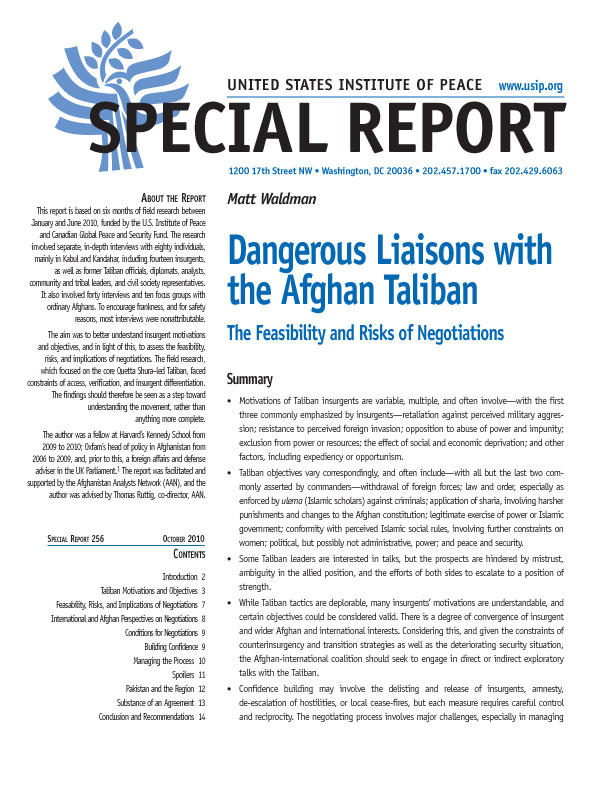This report is based on six months of field research between January and June 2010, funded by the U.S. Institute of Peace and Canadian Global Peace and Security Fund. The aim was to better understand insurgent motivations and objectives, and in light of this, to assess the feasibility, risks, and implications of negotiations.

Summary
- Motivations of Taliban insurgents are variable, multiple, and often involve—with the first three commonly emphasized by insurgents—retaliation against perceived military aggression; resistance to perceived foreign invasion; opposition to abuse of power and impunity; exclusion from power or resources; the effect of social and economic deprivation; and other factors, including expediency or opportunism.
- Taliban objectives vary correspondingly, and often include—with all but the last two commonly asserted by commanders—withdrawal of foreign forces; law and order, especially as enforced by ulema (Islamic scholars) against criminals; application of sharia, involving harsher punishments and changes to the Afghan constitution; legitimate exercise of power or Islamic government; conformity with perceived Islamic social rules, involving further constraints on women; political, but possibly not administrative, power; and peace and security.
- Some Taliban leaders are interested in talks, but the prospects are hindered by mistrust, ambiguity in the allied position, and the efforts of both sides to escalate to a position of strength.
- While Taliban tactics are deplorable, many insurgents’ motivations are understandable, and certain objectives could be considered valid. There is a degree of convergence of insurgent and wider Afghan and international interests. Considering this, and given the constraints of counterinsurgency and transition strategies as well as the deteriorating security situation, the Afghan-international coalition should seek to engage in direct or indirect exploratory talks with the Taliban.
- Confidence building may involve the delisting and release of insurgents, amnesty, de-escalation of hostilities, or local cease-fires, but each measure requires careful control and reciprocity. The negotiating process involves major challenges, especially in managing spoilers on all sides. It requires the support, but not excessive influence, of Pakistan and other regional powers.
- However, this process should not lead to neglecting efforts to build the capacity and legitimacy of the state; a rush to negotiate would be self-defeating. Moreover, the goal should not be a quick deal between power holders, but a settlement that reflects the will and aspirations of the nation.
- An agreement could threaten human rights and freedoms, especially those of women and girls, and democratization. Talks should therefore involve legitimate representatives of Afghan society, and the process should be reinforced by long-term efforts to promote genuine reconciliation between hostile groups. To be effective and enduring, a power-sharing settlement must be inclusive, just, and address the underlying causes of the conflict, especially the abuse of power.
About the Report
This report is based on six months of field research between January and June 2010, funded by the U.S. Institute of Peace and Canadian Global Peace and Security Fund. The research involved separate, in-depth interviews with eighty individuals, mainly in Kabul and Kandahar, including fourteen insurgents, as well as former Taliban officials, diplomats, analysts, community and tribal leaders, and civil society representatives. It also involved forty interviews and ten focus groups with ordinary Afghans. To encourage frankness, and for safety reasons, most interviews were nonattributable.
The aim was to better understand insurgent motivations and objectives, and in light of this, to assess the feasibility, risks, and implications of negotiations. The field research, which focused on the core Quetta Shura–led Taliban, faced constraints of access, verification, and insurgent differentiation. The findings should therefore be seen as a step toward understanding the movement, rather than anything more complete.
The author was a fellow at Harvard’s Kennedy School from 2009 to 2010; Oxfam’s head of policy in Afghanistan from 2006 to 2009, and, prior to this, a foreign affairs and defense adviser in the UK Parliament. The report was facilitated and supported by the Afghanistan Analysts Network (AAN), and the author was advised by Thomas Ruttig, co-director, AAN.